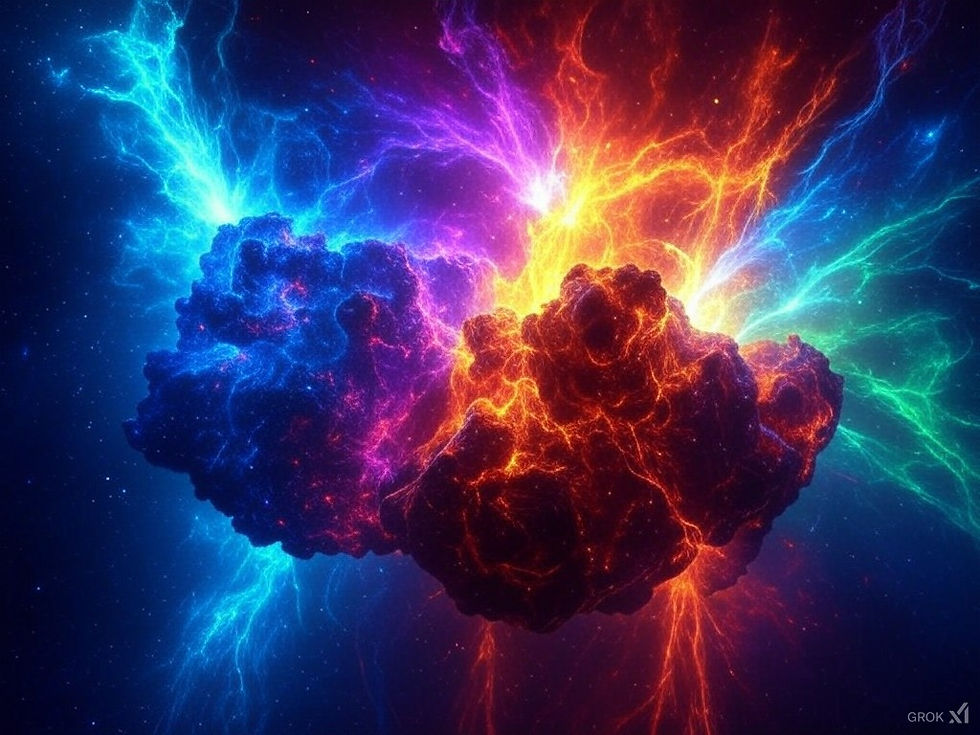The Astronomers Behind the Mystery of Odd Radio Circles
- Lily Grudenic
- Oct 8
- 4 min read

Astronomers have recently revealed the most distant and most powerful Odd Radio Circle (ORC) ever discovered — a colossal, ring-shaped radio structure spanning millions of light-years. This remarkable finding has intensified interest in one of the most mysterious and newly identified astronomical phenomena. First detected in 2019, ORCs remain poorly understood, and each discovery provides valuable insight into the energetic processes shaping galaxies across the universe.
What Are Odd Radio Circles?
Odd Radio Circles are immense, faint rings of radio emission that can only be detected at radio wavelengths. They are invisible in optical, infrared, and X-ray light, making them elusive to most traditional telescopes. Typically, an ORC measures between one and two million light-years in diameter — approximately ten to twenty times larger than the Milky Way galaxy. Many ORCs appear to have a galaxy at their center, suggesting that they are linked to extraordinary cosmic events occurring within these galaxies, such as powerful outbursts from supermassive black holes or intense star formation episodes.
Despite their immense size, ORCs are exceedingly rare. Only a few dozen have been confirmed so far, primarily through large-scale sky surveys conducted using advanced radio telescopes. The rarity and scale of ORCs have made them a focal point for astronomers studying extreme astrophysical processes. Each discovery helps scientists piece together clues about how galaxies evolve, interact, and sometimes explode with tremendous energy.
The Researchers Leading the Way
Some of the world’s leading astronomers have been at the forefront of ORC research. Professor Ray P. Norris, of Western Sydney University and CSIRO (Commonwealth Scientific and Industrial Research Organisation), was among the first to identify these peculiar radio rings using data from the Australian Square Kilometre Array Pathfinder (ASKAP) telescope. Norris continues to play a central role in investigating their origins, proposing that they may result from powerful shock waves produced by galactic-scale explosions or black hole activity.
Another major contributor is Dr. Bärbel S. Koribalski, also of CSIRO, who has worked extensively on identifying and characterizing ORCs using ASKAP and other instruments. Her studies have helped establish the physical properties and large-scale structure of these objects. Dr. Jordan Collier, working with South Africa’s MeerKAT radio telescope, has provided some of the most detailed images of ORCs to date, allowing scientists to observe their internal features with unprecedented clarity. Meanwhile, Professor Elaine Sadler, Chief Scientist at CSIRO’s Australia Telescope National Facility, has been instrumental in coordinating multi-observatory campaigns and interpreting the resulting data.
Major Studies and Discoveries
Several key studies have advanced our understanding of Odd Radio Circles. One important work, “MeerKAT Uncovers the Physics of an Odd Radio Circle” by Ray P. Norris and colleagues, presented high-resolution images of an ORC captured by the MeerKAT telescope in South Africa. This study provided new insight into the radio emission mechanisms and revealed structural details that had previously been unresolved. Another significant paper, “MeerKAT Discovery of a MIGHTEE Odd Radio Circle”, expanded the catalog of known ORCs and showed that they might be more common than initially believed.
In addition, the study “Discovery of Odd Radio Circles and Other Peculiars in the First Year of the EMU Survey” demonstrated the use of advanced image recognition algorithms to identify new ORC candidates automatically. This marked an important step toward large-scale, automated discovery of such structures across the sky. These combined efforts have formed the foundation of our current knowledge about ORCs, though their exact origins remain uncertain.
The New Discovery
The most recent discovery of the most distant and most powerful ORC yet observed has pushed the boundaries of current astrophysical understanding. Its immense size and brightness imply that it formed from an exceptionally energetic event, possibly an enormous eruption from a supermassive black hole in the early universe. The fact that such structures can be observed billions of light-years away suggests that ORCs may have played a role in the evolution of galaxies during the universe’s formative epochs. As telescopes grow more sensitive, astronomers hope to uncover many more examples and trace how these spectacular cosmic rings form and expand over time.
A New Cosmic Frontier
Odd Radio Circles remain among the most intriguing discoveries in modern astronomy. They open a new window into the study of galactic activity and high-energy phenomena that operate on scales far beyond our own galaxy. With the upcoming Square Kilometre Array (SKA) — the world’s largest and most powerful radio telescope — researchers expect to detect thousands more ORCs. Each new detection will help unravel the mysteries of these enormous radio ghosts and shed light on the hidden forces shaping the universe.
References
Collier, J., Norris, R. P., Koribalski, B. S., & Sadler, E. (2022). MeerKAT Uncovers the Physics of an Odd Radio Circle. arXiv:2203.10669.
Koribalski, B. S., Norris, R. P., et al. (2022). ASKAP and the Discovery of Odd Radio Circles. CSIRO Publications.
Norris, R. P., Koribalski, B. S., Sadler, E., & Collier, J. (2022). MeerKAT Discovery of a MIGHTEE Odd Radio Circle. arXiv:2411.17311.
Norris, R. P., et al. (2025). Discovery of Odd Radio Circles and Other Peculiars in the First Year of the EMU Survey Using Object Detection. arXiv:2506.08439.
Sadler, E. (2022). Astronomers Reveal Best Image Yet of Mysterious ORCs in Space. CSIRO News Release.












Comments